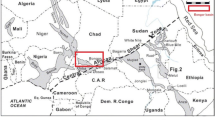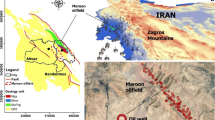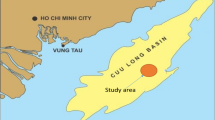Abstract
Ronier oilfield is located in the Bongor basin, lies to the southeast of Chad Lake in Africa is about 300 km from the southeast of capital N’djamena. The Bongor Basin is located at the crossing part of the Central Africa rift zone and the West Africa rift zone. Is a Mesozoic-Cenozoic rift basin develo** the effects of Central Africa Shear zone? The successive discovery of well Ronier 1 in 2007 and well Ronier 4 in 2008 has indicated that they have a potential for commercial exploitation. The reservoir is a braided river delta front facies sediment with a proportion of 78% of sand and 22% of shale. In the actual work, Stochastic Gaussian Simulation algorithm under the phase control based on the collocated co-Kriging is adopted and the models of porosity, permeability and saturation are established. The porosity distributed mainly between 17 to 27%, and 19% on average. Due to the higher logging interpreting oil saturation, 60–72%, which conflicts with the irreducible water saturation of core obtained in the laboratory, a conservative value of 60% was used as the oil saturation of the OOIP calculation this time. The geological models were created this time mainly for Block Ronier 4, which include: KublaI-1, KublaI-2, Mimosa I and Mimosa II. The Original Oil in Place is 321 MMSTB, while the Gas Initial in Place is 514 MSTCF will be developed.









Similar content being viewed by others
References
Ali JK (1994) Neural networks: a new tool for the petroleum industry? In: European petroleum computer conference, Society of Petroleum Engineers
Bai J, Shi Z, Li J, Xue L, He W (2015) In structure and tectonic evolution controls on hydrocarbon accumulation in fractured basement: a case study from Melut basin. In: International conference and exhibition, Melbourne, 13–16, Society of Exploration Geophysicists, p 564
Brooks G, Trang S, Witt P, Khan MNH, Nagle M (2006) The carbothermic route to magnesium. JOM J Miner Met Mater Soc 58(5):51–55
Crompton JW, Flowers GE, Stead D (2018) Bedrock fracture character—Istics as a possible control on the distribution of surge-type glaciers. J Geophys Res Earth Surf 123:853–873. https://doi.org/10.1002/2017JF004505
Dai SH, Wang W, Chen ZG, Luo MB, Yang SL, Liu CF, Zhang YX (2010) Application of slope break controlled deposition theory in oil and gas exploration in Bongor Basin, Chad. Shiyou Diqiu Wuli Kantan (Oil Geophys Prospect) 45:448–453
Davarpanah A, Mirshekari B, Behbahani TJ, Hemmati M (2018) Integrated production logging tools approach for convenient experimental individual layer permeability measurements in a multi-layered fractured reservoir. J Pet Explor Prod Technol 8:743–751. https://doi.org/10.1007/s13202-017-0422-3
Daykin JW, Groult R, Guesnet Y, Lecroq T, Lefebvre A, Léonard M, Prieur- Gaston E (2018) A survey of string orderings and their application to the Burrows–Wheeler transform. Theor Comput Sci 710:52–65. https://doi.org/10.1016/j.tcs.2017.02.021
Djuraev U, Jufar SR, Mahardika H, Ooi PC (2018) Numerical simulation of seismoelectric effect for monitoring foam propagation through a reservoir. J Pet Sci Eng 171:618–635. https://doi.org/10.1016/j.petrol.2018.07.069
Dou L, **ao K, Cheng D, Shi B, Li Z (2007) Petroleum geology of the Melut Basin and the Great Palogue Field, Sudan. Mar Pet Geol 24:129–144
Genik GJ (1992) Regional framework, structural and petroleum aspects of rift basins in Niger, Chad and the Central African Republic (C.A.R.). Tectonophysics 213:169–185
Hasan N, Rahman AA, Alam MS (2018) Validation and verification of CFD prediction of fluid flow of a submerged vertical round jet. Int J Eng Mater Manuf 3:113–121
Helle HB, Bhatt A (2002) Fluid saturation from well logs using committee neural networks. Pet Geosci 8:109–118
Ishak MA, Islam MA, Shalaby MR, Hasan N (2018) The application of seismic attributes and wheeler transformations for the geomorphological interpretation of stratigraphic surfaces: a case study. Geosciences 8:79
Junyi K, Hasan N (2018) Factors that influence the wax deposition in subsea pipelines. Int J Mater Manuf 3(1):1–8
Kefeng H, Min T, Fu** L, Hui B, Min F (2019) Reserves evaluation based on reservoir geological knowledge database. In: Proceedings of the international field exploration and development conference, Springer, Berlin. https://doi.org/10.1007/978-981-10-7560-5_50
Khan MNH, Fletcher C, Evans G, He Q (2001) CFD modeling of free surface and entrainment of buoyant particles from free surface for sumberged jet systems. J ASME Heat Transf Div 369:115–120
Khan MNH, Fletcher C, Evans G, He Q (2003) CFD analysis of the mixing zone for a submerged jet system. Proc ASME Fluids Eng Div Summer Meet 1:29–34
Khan MNH, Witt P, Brooks G, Barton T, Nagle M (2006) Design of supersonic nozzles for ultra-rapid quenching of metallic vapours. In: 2006 TMS annual meeting, San Antonio, TX, vol 2006, pp 699–709
Khan A, Abdullah AB, Hasan N (2012) Event based data gathering in wireless sensor networks. In: Wireless sensor networks and energy efficiency: protocols, routing and management, IGI Global. https://doi.org/10.4018/978-1-4666-0101-7.ch021
Lee K, Lim J, Ahn S, Kim J (2018) Feature extraction using a deep learning algorithm for uncertainty quantification of channelized reservoirs. J Pet Sci Eng 171:1007–1022. https://doi.org/10.1016/j.petrol.2018.07.070
Li S, Hu W (2015) Application of petrel software in reserve estimation in **nli-**nbei Oilfield, Jilin Province, China. In: International conference on materials engineering and information technology applications (MEITA 2015), Atlantis Press
Liu J, Lin C, Yang H, Schulte L, Song X, Li H, **a S (2018a) Three de- positional models interpreting the Late Ordovician deep-water gravity flow systems in the Tarim Basin, Western China. Geol J 53:2240–2257. https://doi.org/10.1002/gj.3062
Liu Z, Forouzanfar F, Zhao Y (2018b) Comparison of SQP and AL algorithms for deterministic constrained production optimization of hydrocarbon reservoirs. J Pet Sci Eng 171:542–557. https://doi.org/10.1016/j.petrol.2018.06.063
Mahdiani MR, Norouzi M (2018) A new heuristic model for estimating the oil formation volume factor. Petroleum 4(3):300–308. https://doi.org/10.1016/j.petlm.2018.03.006
Moussa TM, Patil S, Mahmoud MA (2018) Performance analysis of a novel heavy oil recovery process using in situ steam generated by thermochemicals. In: SPE western regional meeting, Garden Grove, California, USA, 22–26 April 2018
Hasan MIMNHR (2014) Accurate modeling of evaporation and enthalpy of vapor phase in CO2 absorption by amine based solution. In: Separation science and technology, pp 1326–1334
Nakayama K, Hou J (2002) Prediction of reservoir properties by Monte Carlo simulation and artificial neural network in the exploration stage. In: Soft computing for reservoir characterization and modeling. Physica, Heidelberg, pp 15–33
Naser J, Alam F, Khan M (2007) Evaluation of a proposed dust ventilation/collection system in an underground mine crushing plant. In: 16th Australasian fluid mechanics conference, 16AFMC, 2007, Gold Coast, QLD, pp 1411–1414
Olson TM (1998) Porosity and permeability prediction in low-permeability gas reservoirs from well logs using neura networks. In SPE rocky mountain regional/low-permeability reservoirs symposium, Society of Petroleum Engineers
Pyrcz MJ, Deutsch CV (2014) Geostatistical reservoir modeling. Oxford University, Oxford
Rashid H, Hasan N, Nor MIM (2014) Temperature peak analysis and its effect on absorption column for CO2 capture process at different operating conditions. Chem Prod Process Model 9:105–115. https://doi.org/10.1515/cppm-2013-0044
Saeid NH, Hasan N, Ali MHBHM (2018) Effect of the metallic foam heat sink shape on the mixed convection jet im**ement cooling of a horizontal surface. J Porous Med 21:295–309. https://doi.org/10.1615/JPorMedia.v21.i4.10
Selley RC, der Spuy DV (2016) The oil and gas basins of Africa
Sern WK, Takriff MS, Kartom S, Kamarudin MZMT, Hasan N (2012) Numerical simulation of fluid flow behaviour on scale up of oscillatory baffled column. J Eng Sci Technol 7:119–130
Shellnutt JG, Lee TY, Yang CC, Hu ST, Wu JC, Wang KL, Lo CH (2015) Late Permian mafic rocks identified within the Doba basin of southern Chad and their relationship to the boundary of the Saharan Metacraton. Geol Mag 152:1073–1084
Sun J, Li Y (2018) Magnetization clustering inversion—part 1: building an automated numerical optimization algorithm. Geophysics 83:J61–J73. https://doi.org/10.1190/geo2017-0844.1
Tan M, Zhu X, Geng M, Zhu S, Liu W (2017) The occurrence and transformation of lacustrine sediment gravity flow related to depositional variation and paleoclimate in the Lower Cretaceous Prosopis Formation of the Bongor Basin, Chad. J Afr Earth Sci 134:134–148. https://doi.org/10.1016/j.jafrearsci.2017.06.003
Wim JAM, Swinkels H (2001) Guidelines for the evaluation of petroleum reserves and resources. Society of Petroleum Engineers
Witt P, Khan MNH, Brooks G (2007) CFD modelling of heat transfer in supersonic nozzles for magnesium production. In: 136th TMS annual meting, pp 123–132
Zandkarimi G, Rabbani AR (2016) Static model construction for lower Shuaiba Formation (Lower Dariyan). Mar Sci 6:1–10
Zene MTAM, Hasan N, Ruizhong J, Zhenliang G, Trang C (2019) Geological modeling and upscaling of the Ronier 4 block in Bongor basin, Chad. J Pet Explor Prod Technol. https://doi.org/10.1007/s13202-019-0712-z
Zhalehrajabi E, Rahmanian N, Hasan N (2014) Effects of mesh grid and turbulence models on heat transfer coefficient in a convergent–divergent nozzle. Asia Pac J Chem Eng 9:265–271
Zhang L, Bao Z, Dou L, Zang D, Mao S, Song J, Zhao J, Wang Z (2018) Sedimentary characteristics and pattern of distributary channels in shallow water deltaic red bed succession: a case from the Late Cretaceous Yaojia formation, southern Songliao Basin, NE China. J Pet Sci Eng 171:1171–1190. https://doi.org/10.1016/j.petrol.2018.08.006
Author information
Authors and Affiliations
Corresponding author
Additional information
Publisher's Note
Springer Nature remains neutral with regard to jurisdictional claims in published maps and institutional affiliations.
Rights and permissions
About this article
Cite this article
Zene, M.T.A.M., Hasan, N., Ruizhong, J. et al. Volumetric estimation and OOIP calculation of the Ronier4 block of Ronier oilfield in the Bongor basin, Chad. Geomech. Geophys. Geo-energ. Geo-resour. 5, 371–381 (2019). https://doi.org/10.1007/s40948-019-00117-0
Received:
Accepted:
Published:
Issue Date:
DOI: https://doi.org/10.1007/s40948-019-00117-0




